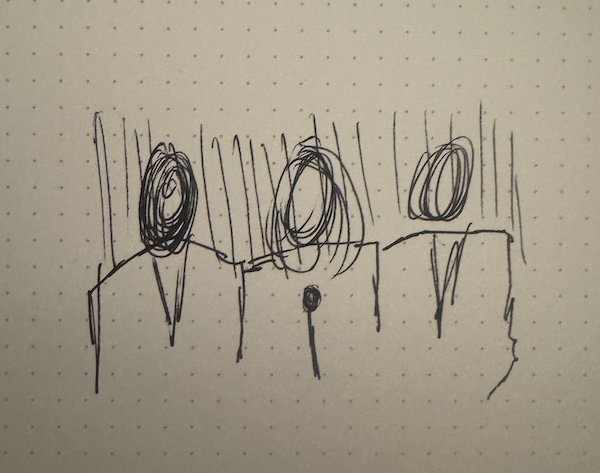Carefree Update
/Here are a couple of updates as I continue to refine my repertoire and my collection of magic items along the Carefree Philosophy. These ideas are specifically in regard to streamlining the physical magic tricks I purchase and keep. To me, there is a psychological weight involved with having 100 gimmicked decks at home. Or having 100 special props in a closet somewhere.
If you see yourself as a magic collector, this isn’t an issue for you. Having a large collection of props and magic gimmicks brings you happiness (I would hope). But I don’t think of myself as a collector.
I’m not someone who wants to invite you into my home to see my large display of antique swords.
I’m someone who wants to go out and stab people in the street.
You see the difference? I’m happy to have a sword collection as large as it needs to be to facilitate more stabbing. But beyond that, I’m not looking to collect more items.
This is true with me with magic as well. I have a small collection of magic books because I think you get new value from a good one each time you revisit it—and because I think a book collection has an aesthetic value I appreciate. But other than that, I want to keep the physical magic items I own as minimal as possible while still having what I need to provide a wide range of magical experiences for people.
Here are two types of magic props/gimmicks I’ve been eliminating from my collection. Perhaps this may inspire you in ways to trim some of the fat from the assemblage of magic in your home (if that’s your wish).
Non-Unique Unitaskers
I wasn’t exaggerating above. I had over 100 gimmicked decks in my collection.
Some of those decks have multiple uses. Like a Svengali Deck, or a Cheek to Cheek Deck which can be used for various types of effects.
Some of those decks were unitaskers, like the Haunted Deck. Uni, meaning one. One task. The decks only did one thing. The Haunted Deck cuts itself without you touching it. That’s the trick. You can present that in a number of different ways. But it still is really just used for that one thing.
One of my first steps in slimming down my collection was getting rid of all non-unique unitaskers. Eliminating down to one Haunted Deck. Eliminating down to one color-changing deck. Do I really nead Card-toon, Card-toon 2, and Fart-toon? Probably not.
Then I looked at the effects these decks can produce more broadly. I had eight or so decks where the cards would be blank and then print, or normal cards would become blank, or all the cards would become blank except the card the spectator named, or something like that. The effects weren’t necessarily identical, but they were close enough that I wouldn’t perform them for the same person. So again, I got rid of all but one.
Then finally, once I had gotten down to a single deck for each broad category of effect, I then asked myself if I could replicate the effect somewhat with a borrowed deck. If the answer was that I could get about 80% close to the effect with a borrowed deck, then I eliminated even this final gimmicked deck.
I can’t get 80% of the way to a specially made color changing deck with a borrowed deck.
But I feel I can get *)% of the way to a gimmicked ACAAN with a borrowed deck. So, for that reason, I didn’t hang onto any gimmicked ACAAN decks.
Using this criteria allowed me to cut down over 100 gimmicked decks to 26. And I’ll probably eliminate some of the remaining ones in the future.
“Everyday Object” Props
This has been a hard one for me to accept. But the moment you do a trick with something—even if it’s something that exists in the real world—it will likely be seen as a magic prop. Unless it’s completely native to the environment.
I’ve known this for some time, but I kind of want it not to be true.
I bought this trick years ago.
It’s a two-phase routine with hotel business cards. First you tell them which hotel they’re thinking of, then you predict which hotel they’ll select.
It’s based on similar routines with playing cards. But aren’t hotel business cards so much more interesting and memorable than playing cards?
And, as the ad says, the props are “totally realistic.”
The problem is, none of that matters. Especially in social magic, which is supposed to have a natural feeling.
If the cards were completely normal and 100% examinable, it still wouldn’t matter. The fact that you have them at all means they’re for a trick and therefore it’s going to feel like a trick.
I now ask myself when looking at a trick with props: “Does anyone carry this in real life?” Does anyone carry bottle caps? Or a stack of receipts. Or a page torn from a magazine?
These are ordinary objects, in a way. But it’s not ordinary to carry them around.
At worst, people will believe the objects are fake or gimmicked.
At best, they’ll see you as someone carrying around little magic props to show people tricks. It’s not the best look.
I actually find it much more natural and realistic to say:
“Here’s something bizarre I bought off the dark web. Watch this weird shit it can do,”
than it is to say:
“Here are five, normal gym membership cards.”
I understand the world of that first statement. A world where people find weird objects online, buy them, and carry them around to show people.
I don’t understand the world of the second statement. One where you’re supposedly carrying around regular objects that no one carries with them, and then acting like it’s normal to do something impossible with these objects no one carries with them.
Again, this is more of a social magic concern. If I was doing a formal show, then yes, maybe I would gather a bunch of hotel business cards to present something to you. But in a real world interaction, I would not.
Working through my collection of tricks with this mindset allowed me to clear out a bunch of effects.
If you have some minimalist tendencies and are looking to flush out some of the physical magic props, tricks, and gimmicks that you’ve accumulated over decades like I have, you may get some benefit out of putting your props through these filters.













